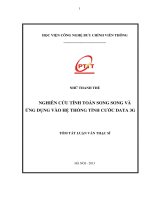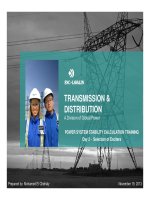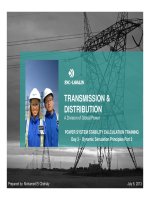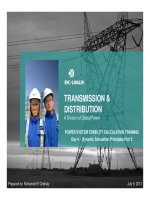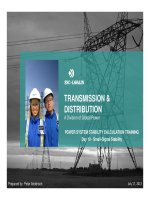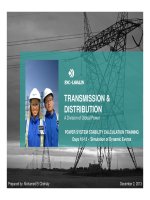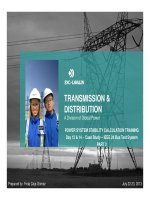Phần 1 KHÓA ĐÀO TẠO TÍNH TOÁN ỔN ĐỊNH VÀ ỨNG DỤNG TRÊN PHẦN MỀM PSSE CHO KỸ SƯ HỆ THỐNG ĐIỆN (Lý thuyết về Ổn định hệ thống điện)
Bạn đang xem bản rút gọn của tài liệu. Xem và tải ngay bản đầy đủ của tài liệu tại đây (2.43 MB, 21 trang )
TRANSMISSION &
DISTRIBUTION
A Division of Global Power
POWER SYSTEM STABILITY CALCULATION TRAINING
D1
BiPiil
Day
1
- Bas
i
c Pr
i
ncip
l
es
•
July4,2013
Prepared by: Peter Anderson
eBook for You
OUTLINE
2
OUTLINE
• Definitions of Stability
T f St bilit
•
T
ypes o
f
St
a
bilit
y
•
Angular Stability Analysis
•
Angular
Stability
Analysis
•
Operational Limits of Synchronous
Operational
Limits
of
Synchronous
Machines
eBook for You
BASIC PRINCIPLES
3
BASIC
PRINCIPLES
Power System Stability:
What does it mean?
A power system at a given operating state is stable if
following a given disturbance or a set of disturbances
following
a
given
disturbance
,
or
a
set
of
disturbances
,
the system state stays within specified bounds and the
system reaches a new stable equilibrium state within a
ifid id fti
spec
ifi
e
d
per
i
o
d
o
f
ti
me
Multi-faceted problem depending on:
Time S
p
an of Interest
p
Nature & Size of the Disturbance
Physical Nature of any resulting Instability
eBook for You
BASIC PRINCIPLES
4
BASIC
PRINCIPLES
Power System Stability:
IEEE/CIGRE Working Group
IEEE/CIGRE
Working
Group
Power system stability is the ability of an electric power
system, for a given initial operating condition, to regain a
state of o
p
eratin
g
e
q
uilibrium after bein
g
sub
j
ected to a
pgq gj
p
hysical disturbance, with most system variables bounded so
that practically the entire system remains intact
It is not necessary that the system regains the same steady state
ti ilib i i t th di t b Thi ld b th
opera
ti
ng equ
ilib
r
i
um as pr
i
or
t
o
th
e
di
s
t
ur
b
ance.
Thi
s wou
ld
b
e
th
e
case when e.g. the disturbance has caused any power system
component (line, generator, etc.) to trip. Voltages and power flows will
not be the same after the disturbance in such a case. Most
disturbances that are considered in stability analyses incur a change
disturbances
that
are
considered
in
stability
analyses
incur
a
change
in system topology or structure.
It is important that the final steady state operating equilibrium after the
fault is steady state acceptable. Otherwise protections or control
actions could introduce new disturbances that might influence the
actions
could
introduce
new
disturbances
that
might
influence
the
stability of the system. Acceptable operating conditions must be
clearly defined for the power system under study.
eBook for You
TYPES OF STABILITY
5
TYPES
OF
STABILITY
PowerSystemStability
Fre q uencyStability
AngularStability
VoltageStability
Small
Disturbance s
Large
Disturbance s
ShortTerm LongTerm
Small
Disturbances
Large
Disturbances
ShortTerm LongTermShortTerm
eBook for You
TYPICAL TIME SPANS
6
TYPICAL
TIME
SPANS
Harmonics
Pow er Flow
FaultCurrents
Long ‐TermStability
Short‐TermStability
Stato rTransi ents
Resonance/Saturation
Resonance/Saturation
Switching
Lightning
Time (s)
Time
(s)
1.E‐06 1.E‐03 1.E+00 1 .E+03
eBook for You
ANGULAR STABILITY
7
ANGULAR
STABILITY
The ability of the Synchronous Machines
within a Power System to remain In
Synchronism following a disturbance
Large Disturbances (Transient Stability)
Small Disturbances (Small
signal or Dynamic
Small
Disturbances
(Small
-
signal
or
Dynamic
Stability)
eBook for You
FREQUENCY STABILITY
8
FREQUENCY
STABILITY
The ability of the Synchronous Machines
ithi P S t t t th S t
w
ithi
n a
P
ower
S
ys
t
em
t
o res
t
ore
th
e
S
ys
t
em
Frequency to within an acceptable range
following a disturbance
following
a
disturbance
Short
-
Term (Governor action)
Short
-
Term
(Governor
action)
Long-Term (Turbines, Boilers, Nuclear Reactors)
eBook for You
VOLTAGE STABILITY
9
VOLTAGE
STABILITY
At every node in the system, the “Actual
Injected Reactive Power” is equal to the
Injected
Reactive
Power”
is
equal
to
the
“Desired Injected Reactive Power” required
to maintain the node voltage within
tbl li it
accep
t
a
bl
e
li
m
it
s
Local in nature since it is difficult to transport
Local
in
nature
since
it
is
difficult
to
transport
reactive power through the network (X>>R)
Short-Term (1-5 s Induction motors, Electronically
controlled loads, HVDC converters)
controlled
loads,
HVDC
converters)
Long-Term (10s-5 m Tap changers,
Thermostatically controlled loads, Generation
current limiters
)
)
eBook for You
APPLICATION OF ANGULAR STABILITY
10
ANALYSIS
Disturbance
Corrective
Actions
STATE‐A
STATE‐A'
STATE‐B
State-A: Power Flow
St t
BP Fl
St
a
t
e-
B
:
P
ower
Fl
ow
Transit from State
-
A to State
-
A
’
: Stability Analysis
Transit
from
State
-
A
to
State
-
A:
Stability
Analysis
Transit from State-A’ to State-B: Stability Analysis
eBook for You
SYNCHRONOUS MACHINES
11
SYNCHRONOUS
MACHINES
Single Phase Equivalent of a 3-phase Generator
jXd I
EU
~
Im
E
jXd I
jXd
.
I
δ Re
θ U
I
I
eBook for You
SYNCHRONOUS MACHINES
12
SYNCHRONOUS
MACHINES
Power-An
g
le Relationshi
p
gp
∂sin
X
U.E
=P
d
1.2
1.4
04
0.6
0.8
1
Powe r(pu)
0
0.2
0
.
4
0 30 60 90 120 150 180
LoadAngle(deg)
eBook for You
STEADY
STATE OPERATIONAL LIMITS
13
STEADY
-
STATE
OPERATIONAL
LIMITS
Limiting Factors:
Stator Current Thermal Limit
•
Rated Current (1 0 pu)
•
Rated
Current
(1
.
0
pu)
Field Current Thermal Limit
•Short Circuit Ratio (SCR≈1/Xd)
R t A l St bilit Li it
R
o
t
or
A
ng
l
e
St
a
bilit
y
Li
m
it
•Dependent on Exciter Speed of Response
eBook for You
OPERATIONAL LIMITS FOR SYNCHRONOUS
14
GENERATORS
Xd=2.0pu
SCR=0.5
Powerfactor=0.8
Exciter No‐loadMargin Full‐loadMargin
Slow‐Actin
g
35% 20%
g
Fast‐Acting 20% 10%
eBook for You
OPERATIONAL LIMITS FOR SYNCHRONOUS
15
GENERATORS
Stator Current Limit
1.25
Stator
Current
Limit
I
rated
=1.0pu
Centre = 00
0.75
1
Q
Centre
=
0
,
0
Radius=1.0
0
0.25
0.5
P
‐0.5
‐0.25
00.250.50.7511.25
P
‐
1.25
‐1
‐0.75
1.25
eBook for You
OPERATIONAL LIMITS FOR SYNCHRONOUS
16
GENERATORS
Field Current Limit
1.25
Q
Field
Current
Limit
I
Frated
=√{(SCR+sinθ)
2
+cosθ
2
}
Centre = 0
‐
SCR
05
0.75
1
Q
Centre
=
0
,
‐
SCR
Radius=I
Frated
0
0.25
0
.
5
P
I
Frated
=√{(0.5+0.6)
2
+0.8
2
}
=
1.36
‐0.5
‐0.25
0 0.25 0.5 0.75 1 1.25
1.36
Centre=0,‐0.5
‐1.25
‐1
‐0.75
eBook for You
OPERATIONAL LIMITS FOR SYNCHRONOUS
17
GENERATORS
Rotor Angle Stability Limit
1
Q
Rotor
Angle
Stability
Limit
LowerFieldVoltage=LessStability
Fast‐actingExciter:
0.25
0.5
0.75
NLMargin(NLM)=0.2
FLMargin(FLM)=0.1
‐0.25
0
0 0.25 0.5 0.75 1 1.25
P
Q=tanα *Pg ‐ (SCR‐NLM*cosθ)
•tanα =tanβ‐NLM[0.258]
•
cos
β
= 1/(1+FLM) [0 909
β
= 24 6⁰]
‐
1
‐0.75
‐0.5
•
cos
β
=
1/(1+FLM)
[0
.
909
,
β
=
24
.
6⁰]
Q=‐0.34forPg=0
Q=0.258*0.8‐(0.5‐0.2*0.8)=‐0.134forPg=0.8
‐1.25
1
eBook for You
OPERATIONAL LIMITS FOR SYNCHRONOUS
18
GENERATORS
Composite Operating Limits
1.25
Composite
Operating
Limits
Limits are reduced by:
0.75
1
Q
Limits
are
reduced
by:
•HighXd/LowSCR
•
Slow Exciter
0
0.25
0.5
P
Slow
Exciter
‐0.5
‐0.25
0
0 0.25 0.5 0.75 1 1.25
P
‐1
‐0.75
‐1.25
eBook for You
OPERATIONAL LIMITS FOR SYNCHRONOUS
19
GENERATORS
Case Study
Case
Study
UsingMS‐Excel,constructthemachinecapabilitycurvefor
thefollowinggenerator:
RatedMVA=200MVA
Xd = 15
Xd
=
1
.
5
Ratedpowerfactor=0.9
Using
a. SlowExciter
b. FastExciter
eBook for You
OPERATIONAL LIMITS FOR SYNCHRONOUS
20
GENERATORS
Case Study
/ /
RatedMVA=200MVA
/
Xd=1.5
/
Ratedpowerfactor=0.9
220
180MW Generator/Slow-Acting Exciter
RATED MW
140
160
180
200
220
(
MW)
60
80
100
120
140
R
EAL POWER
(
0
20
40
60
-
100
-
75
-
50
-
25
0
25
50
75
100
125
150
175
R
100
75
50
25
0
25
50
75
100
125
150
175
REACTIVE POWER (MVAR)
eBook for You
OPERATIONAL LIMITS FOR SYNCHRONOUS
21
GENERATORS
Case Study
/
/
RatedMVA=200MVA
/
Xd=1.5
/
Ratedpowerfactor=0.9
220
180MW Generator/Fast-Acting Exciter
RATED MW
140
160
180
200
220
(MW)
60
80
100
120
140
R
EAL POWER
0
20
40
-1
00
-7
5
-
50
-2
5
0
2
5
50
7
5
1
00
12
5
1
50
17
5
R
00
5
50
5
0
5
50
5
00
5
50
5
REACTIVE POWER (MVAR)
eBook for You
